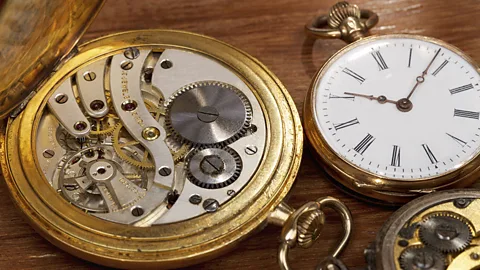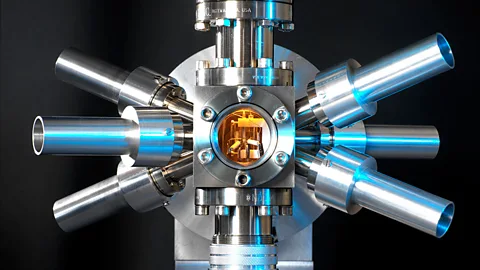Time lords: The clocks that rule our world

The best clocks now lose only a second every 300 million years – and the minuscule differences in their time-keeping is changing the world we live in. David Robson reports.
Time is money – and never was this clearer than at 09:59:59.985 Eastern Time, on 3 June 2013. Due to a glitch in its time-keeping, the news agency Reuters accidentally released trading data just 15 milliseconds early. The result was $28m of transactions, as robot traders started dealing before others could get a look in.
Technology has now reached a stage where even the tiniest discrepancies can be of huge cost, pushing us towards a new era of time-keeping. The most accurate clocks can tick for more than 300 million years without losing a beat – and that is by no means the limit. Those time lords can influence everything from the financial markets to your car’s GPS. They may even allow us to test the substance of the universe itself.
Improvements in time-keeping have always been central to society's progress, since we stopped measuring its passage with the movement of the sun. The invention of the mechanical clock revolutionised sea-faring, for instance – since they allowed sailors to estimate their longitude, and in doing so it fuelled the age of discovery and colonialism. It also fuelled advances in astronomy, as stargazers could measure the path of heavenly bodies with greater precision.
Precise frequency
Even the best mechanical clock would not be suitable for today’s standards, however. A grandfather clock, for instance, loses about 15 seconds a day – an eon in comparison to the accuracy achieved by our gold standard, atomic clocks. Invented 60 years ago, they work by bathing a ball of caesium atoms in microwaves. The microwaves are tuned so that they are completely absorbed and then re-emitted by the caesium – which theory tells us should happen when the microwaves reach a frequency of precisely 9,192,631,770 oscillations per second. Measuring those oscillations therefore offers a very precise “tick” that is used to gauge the passing of time – in much the same way that the regular swing of the pendulum powers a mechanical clock.
The National Institute of Standards and Technology explain the principle
Today, one of the most accurate of these atomic clocks lies in the National Physical Laboratory (NPL) in Teddington, England – it loses about one second every 138 million years. Last year, it was just beaten into second place by a clock at the National Institute of Standards and Technology in Boulder, Colorado, which loses just one second every 300 million years. The secret was to cool it down to the temperature of liquid nitrogen, says Steven Jefferts at NIST, which minimises tiny errors. But this is not the kind of clock you could hang on your wall; it is about the size of a room. In reality, the device doesn’t even have a clock face: it is instead used to measure the error in other atomic clocks, so they can be calibrated more accurately. “It’s like if you have a wristwatch, and know that it runs 10 seconds slow each day – you can then reset the time,” says Jefferts.

Together, a network of such atomic clocks helps form a network that defines the official time across the world. You almost certainly tap into that network without even realising it. Atomic clocks help measure the frequencies of radio waves used to broadcast TV, for instance. GPS, meanwhile, works by measuring the slight delays in signals sent from different satellites – and from those differences, it can work out your distance and location on a map. None of that would be possible without an atomic clock to measure the most minuscule of differences.
Often, the problems lie not in the time-keeping itself, but the way that information is shared – as the blip in Reuter’s system helps illustrate. Leon Lobo at the UK’s National Physical laboratory points out that much of today’s economy is driven by “high-frequency trading” – using automated systems to do dealings in the fraction of a second. The problem is, each institution’s clocks may be slightly out. “As you go below microsecond level you find no one has the same time,” says Lobo. “If the receiver’s clock is ahead, it looks like the data have arrived before they even left.” Some traders can then exploit these differences to make money.
Buying time
Although the satellite signals used for GPS can help even out the differences, they are vulnerable to hacking. “You can buy GPS jammers that could take out city block – at a cost of £20,” Lobo says. Sometimes the threat is not even intentional; delivery drivers might use them to hide their detours from their manager, while taking out all the buildings along the way, for example.
As a solution, NPL is now providing an underground network that wires each institution into its own atomic clocks – meaning that each office uses the same source of time keeping. It is delivered, he says, in a “dark network” – meaning that no other signals can be transmitted through its cables. In this way, “time” has become something of a utility – like electricity or broadband – that you need to order on demand. “Suddenly, the user has their network, time and power coming out of their wall – they just have to consume it,” is how Lobo describes his service.

Within a decade, even today’s best atomic clocks may seem as out-of-date as our old grandfather clocks. In place of caesium, scientists are now turning to other materials like strontium that can be excited by visible light, and which turn out to be even more accurate. These clocks could have barely lost its pace since the big bang, says Lobo. “You are looking at one second over the whole lifetime of the Universe.”
Lobo points out that these clocks are so sensitive they will be subjected to the mind-boggling physics described by Albert Einstein’s theories of relativity. Einstein predicted that the force of gravity can slow down the passage of time, for instance – meaning time passes slightly more quickly the higher you are. We already know that today’s atomic clocks feel this effect at high altitude compared to sea level – but the precision of optical clocks would be immediately obvious even over much shorter distances. “Simply raising an optical clock by a centimetre changes its frequency,” says Lobo. In this way, it becomes a gravity-metre that could probe the inside of the Earth – to discover deposits of oil or gas that might change the Earth’s pull in a specific location. “Those are the disruptive applications that will come out,” says Lobo.

It is even possible that something unexpected will turn up, says Jefferts. Supposing that we find that the clock’s frequency changes minutely over time? “You’d worry that the laws of physics themselves are changing,” he says – contrary to our long-held assumption that they remain constant.
If the history of ticks and tocks tells us anything, it is that each new advance has fired other revolutions – from sea-faring to GPS and mobile telephones. Will these latest devices be similarly revolutionary? For that, only time will tell.
